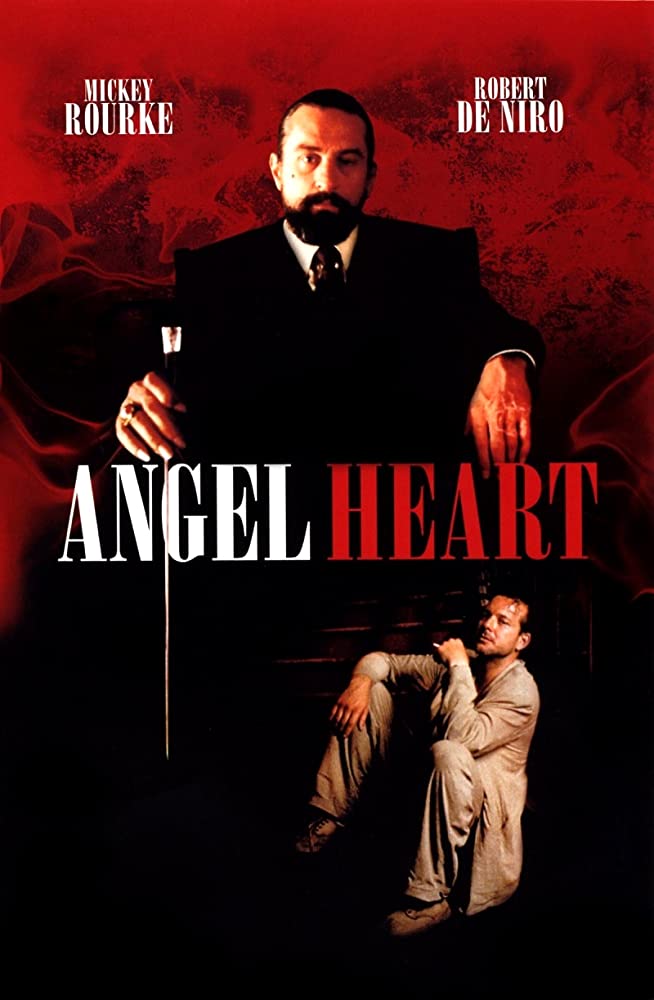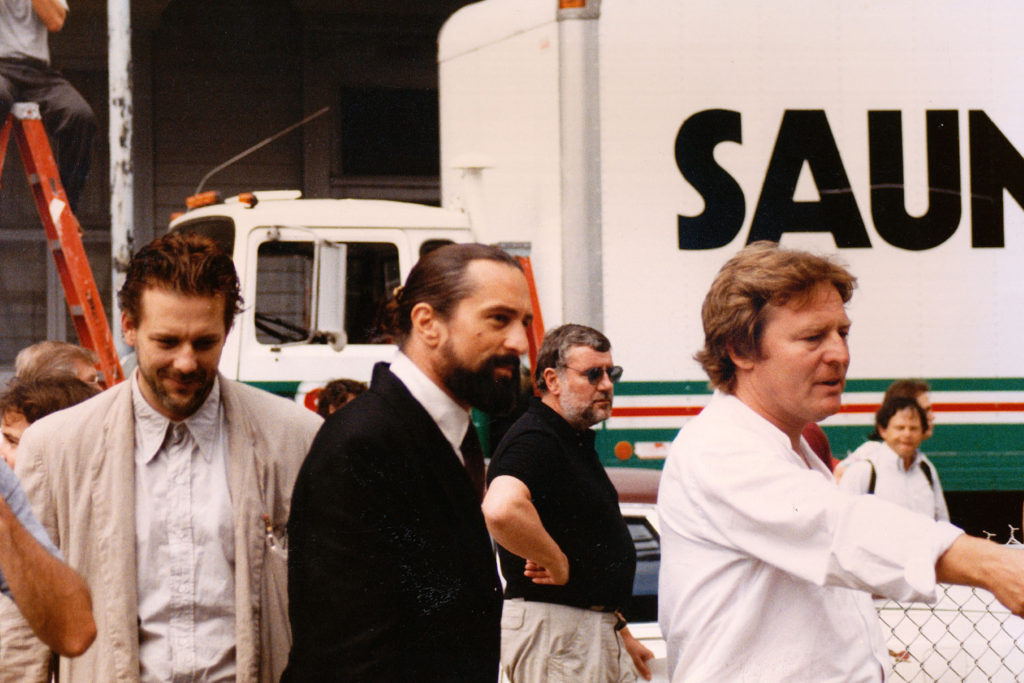“However you sneak up on a mirror, your reflection always looks you straight in the eye” – Louis Cyphre
In 1985 director Alan Parker was learning that getting Robert De Niro to commit to a project was no easy feat. De Niro was easily considered one of the most respected screen actors on the planet and had a notorious reputation for choosing and taking any roles he signed onto extremely seriously. Parker himself was no novice. The British director already very prolific, had a slew of critically and commercially successful films under his belt including his first feature film Bugsy Malone a musical twist on the gangster films of the 1930’s with a cast comprised entirely of children including Scott Baio (Happy Days) and Jodie Foster (Silence of the Lambs) Malone received five British Academy awards and his second Movie Midnight Express even bagged him an Oscar nomination for “Best Director.” Parker wanted to do something darker, though (if you have seen Midnight Express that is saying something), he was attracted to the idea of a mystery thriller. Something that would stretch his directing chops and leave an undeniable mark on an audience. He found his source material when he was reintroduced to a book he had previously read titled “Falling Angel”; a detective noir thriller written by author William Hjortsberg. Set in New York, the story follows Private Detective “Harry Angel,” who is hired by the mysterious “Louis Cyphre”, to track down one “Johnny Favorite” who has seemingly vanished while engaged in an unspecified contract with Cyphre. Quickly Angel finds himself in deep, and as bodies start piling up around him, he realizes not all is as it seems.
Parker wanted De Niro from the start. He was a great admirer of his work and felt that De Niro would be perfect for the lead role of Harry Angel. Also, attaching De Niro to any project was sure to secure funding and help get the movie made. Reading an early draft of the script De Niro was indeed interested but not in the role of Harry Angel; he was more drawn to the enigmatic Cyphre. De Niro was non-committal though, he had no shortage of project choices and he would take his time before agreeing to participate and lend his considerable talents to any production.

Meanwhile, Parker kept working on the script and assembling his cast with his hopes for De Niro’s involvement on the back burner. Relocating the second half of the action in the story to New Orleans was the major change from the original novel. Parker spent a lot of time in the small shadowy bars of New Orleans honing the script and absorbing the atmosphere of the unique city. Mario Kassar and Andrew Vanja, producers known for Rambo, Terminator 2, Total Recall and others, were enthusiastic about the script and agreed to finance the movie with the understanding that De Niro had been circling the project.
Now Parker began meeting with actors for the lead role of Harry Angel. After meeting Mickey Rourke and walking the streets of New York through the night with him, Rourke declared that Parker should stop looking for other actors, the role was his. Impressed by Rourke’s confidence, Parker made him his Angel. Lisa Bonet a beautiful fresh-faced star from the popular Cosby Show on TV was cast as “Epiphany Proudfoot”. At nineteen Bonet was the youngest cast member but her involvement would generate a lot of interest in the project, as she was very hot at the time. The role of Cyphere was still vacant though. Kassar and Vanja kept pushing Parker to get a commitment from De Niro who, much like the character, was proving elusive. Parker met with Jack Nicholson who had just acquired a new art piece from Sotheby’s and there had been a mistake with his delivery. Parker found that Nicholson was distracted with the safe arrival of his new purchase and not the matter at hand. Marlon Brando had given a polite “maybe” and after being chased for an answer an even politer “no thank you”. Maybe De Niro was toying with Parker because it was on a St Patrick’s day morning that the director received a message from De Niro, simply saying, ‘’I am of a mind to do the film”. With his cast set production began and De Niro threw himself into the role. Costumes were brought from Rome and at least 20 canes were flown in from France a little shop De Niro had discovered so he could get the right feel for the character and take the costumes home with him so he could rehearse in full Cyphere regalia. Long nails were added to De Niro’s hands, which would grow longer as the story went on and the actor suffered the discomfort of several different contact lenses so he could get the look of the strange character just right. The actor’s hair was long and would be kept that way, but worn up for the majority of the movie and released, in all it’s flowing glory, for his final appearance.
When shooting scenes with De Niro and Rourke, Parker made sure he had two cameras set, one on each actor so he could capture any inspired genius the unpredictable performers might have thrown at each other. Parker has said that watching the two actors work was like watching two prizefighters testing each other out as they slowly encircled, an adlibbed jab here and wisecrack left hook there. At the time, Rourke was being compared to De Niro as one of the hottest young actors on the scene, so watching these two experts play off of each other must have been mesmerizing. The mere presence of De Niro generated electricity and made everyone up their game with a renewed focus and energy. Parker has said that although he didn’t learn anything specific from De Niro it was his pursuit of truth and extreme thoroughness and phenomenal concentration that reminded him of all the important techniques he had learned as a filmmaker. Every night before going to sleep Parker would read a passage from Aleister Crowley’s “Satanic Diaries” so he could hit the tone of the film correctly the following day. The film oozes sinister energy and its use of overhead fans, a recurring shot throughout the film, makes the audience feel the heat and adds to the unease and clamminess. Shooting the scene in the church where Heart meets Cyphere, a defrocked priest was brought in to stage the background mass. A real priest refused to do it due to the film’s subject matter. So the ex priest was brought in, the reason the Priest became defrocked was never discovered.

The film completed production in February of 1987 it then had to go through the process of being rated by the MPAA who initially gave it an X rating. A scene, which shows Mickey Rourke’s bare backside, was considered a little too explicit for the US in 1987 so cuts were ordered. Parker felt losing a few seconds of Mickey’s butt wasn’t going to hurt the film so the cuts were made. The controversy continued after the film was released though. The graphic sex scene between Bonet and Rourke didn’t sit well with Bonet’s boss Bill Cosby who promptly sacked her from his show. Overall, the film performed favorably with critics and audiences alike. It retains cult status to this day maybe because it features one of the most shockingly disturbing twists in cinema history, which we won’t reveal here. Suffice to say if you have never seen Angel Heart it is worth checking out just for this and of course the commanding presence of Robert De Niro. One of the most memorable scenes in the film features De Niro peeling an egg with his long nails and announcing to Angel that, “in some religions the egg is the symbol of the soul”. He stares at Rourke with ultimate control before he pushes the egg into his mouth never breaking his gaze and quite literally swallows the soul of our hero pushing us a little deeper into the madness of this memorable movie.